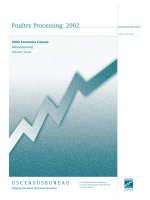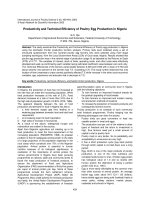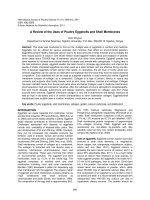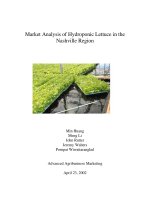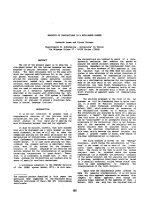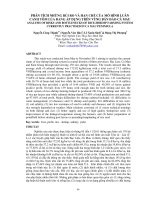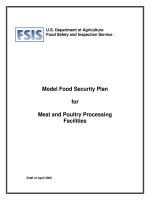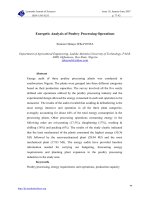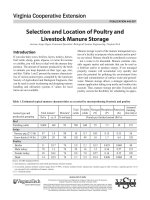Energetic Analysis of Poultry Processing Operations potx
Bạn đang xem bản rút gọn của tài liệu. Xem và tải ngay bản đầy đủ của tài liệu tại đây (202.34 KB, 16 trang )
Leonardo Journal of Sciences
ISSN 1583-0233
Issue 10, January-June 2007
p. 77-92
77
Energetic Analysis of Poultry Processing Operations
Simeon Olatayo JEKAYINFA
Department of Agricultural Engineering, Ladoke Akintola University of Technology, P.M.B.
4000, Ogbomoso, Oyo State, Nigeria
Abstract
Energy audit of three poultry processing plants was conducted in
southwestern Nigeria. The plants were grouped into three different categories
based on their production capacities. The survey involved all the five easily
defined unit operations utilized by the poultry processing industry and the
experimental design allowed the energy consumed in each unit operation to be
measured. The results of the audit revealed that scalding & defeathering is the
most energy intensive unit operation in all the three plant categories,
averagely accounting for about 44% of the total energy consumption in the
processing plants. Other processing operations consuming energy in the
following order are eviscerating (17.5%), slaughtering (17%), washing &
chilling (16%) and packing (6%). The results of the study clearly indicated
that the least mechanized of the plants consumed the highest energy (50.36
MJ) followed by the semi-mechanized plant (28.04 MJ) and the most
mechanized plant (17.83 MJ). The energy audits have provided baseline
information needed for carrying out budgeting, forecasting energy
requirements and planning plant expansion in the poultry processing
industries in the study area.
Keywords
Poultry processing, energy requirement, unit operations, production capacity
Energetic Analysis of Poultry Processing Operations
Simeon Olatayo JEKAYINFA
78
Introduction
Following the ban on the importation of poultry products by the Federal Government
of Nigeria as policy measures to revive the economy and encourage the local poultry farmers,
there has been an increase in the number of poultry processing plants in the country. A poultry
processing plant is an integral part of an extensive poultry-farming venture comprising also
the breeder flocks, hatchery, feed mill, broiler flocks and other related services. These areas of
poultry business are mostly owned and controlled by a single organization. Poultry processing
consists of five easily defined unit operations (Figure 1): slaughtering, scalding &
defeathering, eviscerating, washing & chilling and packaging. All these process operations
require energy in one form or the other, either as fossil fuel, electricity or human labour.
Electricity is used for refrigeration, lighting, air conditioning and other mechanical drives.
Fossil fuels are used for production of hot water for defeathering operation.
Figure 1. Flow diagram of poultry processing
Bird
Slaughtering
Scalding
&
Defeathering
Washing
&
Chilling
Blood
Feathers
By-product
processing
Evisceration
Feet Heads
Intestine
Lungs Trim
Steam or
Hot water
Ice
Packaging
Processed
Chicken
Leonardo Journal of Sciences
ISSN 1583-0233
Issue 10, January-June 2007
p. 77-92
79
The actual significance of energy costs in a particular processing industry is dependent
on the type of products manufactured, the processing methods adopted and the relative price
of energy. The primary objective of any energy management scheme is to minimize the
energy cost component of the production costs, but not at the expense of product quality or
higher overall costs (Miller, 1986). Energy is one of the largest components of the production
cost and the efficiency of its use will often be compromised in favour of other equally
important factors. The need for such great attention to energy management has been
highlighted by several published surveys of energy use in agricultural processing operations.
These include: palm kernel oil processing (Jekayinfa, 2004; Jekayinfa, & Bamgboye, 2004),
cashew-nut processing (Jekayinfa, & Bamgboye, 2003; Jekayinfa, & Bamgboye, 2005),
vegetable canneries (Vergara, Rao & Jordan, 1976), tobacco curing (Cundiff, & Dodd, 1981),
rice processing (Ezeike, 1981; Verma, 2002), sunflower oil expression (Farsaie & Singh,
1985), milk processing (Harris, 1982; Elsy, 1980 & Wilhem, Suter & Brusewitz, 2004),
poultry processing in USA (Whitehead & Shupe, 1979; Baughman & Parkhurst, 1977 &
USDC, 1993).
Very few processing factories have any precise idea of the energy consumption of
different production areas and in the absence of detailed internal monitoring; the energy
efficiencies of different operations are also usually unknown. The knowledge of energy
consumption in each unit operation of a production system is useful for determining high-
energy consuming areas. These areas can only be identified by methodological energy
analysis of all processing operations. Energy analysis allows the energy cost of existing
process operations to be compared with that of new or modified production lines. It also
enables a plant operator to compare his energy efficiency with that of a competitor or with
that of another factory within the same company. Finally, the knowledge of energy
consumption for each product in a factory is useful for several purposes such as budgeting,
evaluation of energy consumption for a given product, forecasting energy requirement in a
plant, and for planning plant expansion.
There is no known report in the literature on the energy requirements of poultry
processing operations as practiced in Nigeria. Such information is vital so as to enable the
management of this industry to develop strategies for better control of their production
operations and modify areas of waste. It will also enable the management to properly appraise
their energy consumption for effective planning of production network. The present study is
Energetic Analysis of Poultry Processing Operations
Simeon Olatayo JEKAYINFA
80
to estimate energy requirement in the eight readily defined poultry processing operations as
practiced in Nigeria. The study will provide an opportunity for having a reliable database
concerning consumption of various types of energy by different users in poultry processing
ventures. It will also provide a firm basis of identifying options for saving energy in poultry
process operations.
Plant description
The three poultry processing plants selected for case studies represent typical
operations in the Southwestern part of Nigeria. The energy data collected do not however
represent an industry average or normal. The characteristics of the three plant categories are
discussed below:
Category 1: This is regarded as the small size plant that processes at a rate of 10,000-
processed chicken per day.
Category II: This plant, categorized as a medium single-shift plant, has a production rate of
20,000 birds per day.
Category III: This is categorized as large plant with a production rate of 30,000 chickens per
day.
The processing techniques and facilities of all the three plants differ, as do the type
and make of equipment, and the degree of mechanization of operations.
Processing technology of poultry and methods of energy evaluation
Poultry undergoes some sequential processing operations, which convert it to the final
primary product known as chicken. The sequence of poultry operations common in the three
plants surveyed is outline in Figure 1. At each stage of the unit operations, some level of
energy input is required in the form of electrical energy, thermal energy and human energy.
The type and magnitude of the energy consumed is a function of the technology employed
and the number of birds being processed. In order to quantify the energy demands of each unit
operation, quantitative data on operating conditions would be required for each unit operation.
Leonardo Journal of Sciences
ISSN 1583-0233
Issue 10, January-June 2007
p. 77-92
81
Table 1 summarizes the production technologies under study in the three poultry
processing plants.
Table 1. Measured parameters for evaluating energy input data in poultry processing plants
S/N Operation Required parameters
1. Slaughtering
• Electrical power, kW
• Fuel consumed,
l
• Calorific value of fuel used, J/ l
• Time taken for drying, h
• Number of persons involved in cleaning
2. Scalding &
defeathering
• Electrical power, kW
• Fuel consumed, l
• Calorific value of fuel used, J/ l
• Time taken for soaked, h
• Number of persons involved in soaking or conditioning
3 Eviscerating
• Electrical power, kW
• Fuel consumed, l
• Calorific value of fuel used, J/ l
• Time taken for roasting, h
• Number of persons involved in roasting
4. Washing & chilling
• Electrical power, kW
• Fuel consumed, l
• Calorific value of fuel used, J/ l
• Time taken for shelling, h
• Number of persons involved in shelling
5. Packaging
• Electrical power, kW
• Fuel consumed,
l
• Calorific value of fuel used, J/
l
• Time taken for kernel separation, h
• Number of persons involved in separation
The types and magnitudes of the parameters required for the energy evaluation of each
unit operation are presented in Table 2.
Ezeike (1981) and Jekayinfa and Bamgboye (2003, 2005) have used similar procedure
in the energy audits of rice processing mills, palm-kernel oil mills and cashew-nut mills in
Nigeria. The energy evaluation method for each unit operation follows:
Slaughtering
The process of poultry processing begins by removing feeders the night before birds
are to be dressed. This empties the gut and reduces fecal contamination if the intestines are cut
Energetic Analysis of Poultry Processing Operations
Simeon Olatayo JEKAYINFA
82
during evisceration.
Table 2. Processing techniques at the three poultry processing plants
Equipment and principle adopted
S/N Operation
Plant A Plant B Plant C
1.
Slaughtering
Manual
killing
Manual with cone
killing stand and
stunner/sticking
knife
Semi automated with
stunner/sticking
knife
Motorized with complete
hanging/sticking/bleeding
equipment comprising: loading
bar, overhead conveyor for killing
and bleeding out, shackles and
bleeding trough
2.
Scalding &
Defeathering
Manual with
holding table,
bowl, plucker
feather bins and
mobile racks
Semi automated
incorporating a wet
scald system with
pin feathers remover
and dry plucking
machine
Motorized with flight feather
remover, feather bins and pinning
table or finisher
3. Evisceration
Manual with an
over head rail,
carousel or table
Manual with an
overhead rail and
carousel or table
Evisceration unit comprising
conveyor line, shackles,
evisceration trough and mobile
offal track. Giblet processing unit
and Gizzard skinner
4.
Washing &
chilling
Carcases are spray-
washed and chilled
rapidly before
packaging
Semi automated with
carcase washer and
sink unit
Semi automated with ice tank or
spiral washer chiller
5. Packaging Manual Manual
Semi automated by over-wrapping
and bag wrapping
Two main methods are employed; manual method and automated method. In the manual
method, the bird is held in a small cloth bag that has a very small part of one corner cut off.
The head and neck are thereafter drawn through the hole in the corner and the neck is cut
through the earlobe from top to bottom with a swift from stroke of the knife. The automated
method involves the use of a stunner/sticking knife. The energy consumed per 1000 birds is
obtained from the expression.
E
s
= 3.6 [k
s
P
s
t
s
+ 0.075 N
s
t
s
] (1a)
when electricity is used or
E
s
= W
s
C
s
+ 3.6 [0.075 N
s
t
s
] (1b)
when I.C. engine is used or
E
s
= 3.6 [k
s
P
s
t
s
+0.075 N
ss
t
s
] + W
s
C
s
(1c)
when both electricity and I.C. engine are used or
E
s
= 3.6 [0.075 N
s
t
s
] (1d)
Leonardo Journal of Sciences
ISSN 1583-0233
Issue 10, January-June 2007
p. 77-92
83
when poultry processing is totally carried out manually; where 3.6 = Conversion factor (1
kWh = 3.6 MJ), and 0.075 = the average power of a normal human labour, kW.
Scalding and defeathering
The scald water is prepared at 138 - 140°F. In the manual method of scalding, the bird
is held by the feet and its head is plunged first into the scald water. The bird is kept fully
submerged in the scald water while it is worked up and down to get the water well under the
feathers for about 1 - 3 minutes. The scalded bird is re hung or placed on a table top, where
the main wing and tail feathers are pulled first. Thereafter the body feathers are plucked by
pulling against the grain. This process required speed while the carcass is warm. To remove
the pinfeathers, a table knife is employed. The automated method comprises an electric motor
driving a shaft supported by a bearing assembly. The plucking head, driven by a belt, consists
of a series of rotating plates held at an angle by a thrust plate at each end of the plate bearing.
As the discs rotate they come together, drag in the feathers, grip them and pull them from the
bird. As the discs continue to rotate, they separate, and release the feathers into a collection
bag to the rear of the machine. The energy consumed for scalding & defeathering per 1000
birds is obtained from the expression:
E
sd
= 3.6 [k
sd
P
sd
t
sd
+0.075 N
sd
t
sd
] (2a)
when electricity is used or
E
sd
= W
sd
C
sd
+ 3.6 [0.075 N
sd
t
sd
] (2b)
when I.C. engine is used or
E
sd
= 3.6 [k
sd
P
sd
t
sd
+0.075 N
sd
t
sd
] + W
sd
C
sd
(2c)
when both electricity and I.C. engine are used or
E
sd
= 3.6 [0.075 N
sd
t
sd
] (2d)
when scalding & defeathering is totally carried out manually.
Evisceration
The carcass is hung by the feet and the defeathered bird is cut around the neck at the
base of the head. The head is then twisted and pulled off and other internal organs removed.
The automated method involves the use of machinery that is able to slit the necks, detaching
from crop and depositing into evisceration through. It also involves: Cutting round vents and
opening aperture, drawing out viscera but leaving it attached to the carcass, removing liver,
Energetic Analysis of Poultry Processing Operations
Simeon Olatayo JEKAYINFA
84
hearts and gizzards and placing them in the appropriate giblet trays, detaching inedible offal
and allowing it to fall into the evisceration trough.
The energy consumed for eviscerating 1000 birds is obtained from the expression:
Ee = 3.6 [ke Pe te +0.075 Ne te] (3a)
when electricity is used or
Ee = We Ce + 3.6 [0.075 Ne te] (3b)
when I.C. engine is used or
Ee = 3.6 [ke Pe te +0.075 Ne te] + We Ce (3c)
when both electricity and I.C. engine are used or
Ec = 3.6 [0.075 Nc tc] (3d)
when is totally carried out manually.
Washing & Chilling
A mechanized washing device followed eventually by chilling often complements a
continuous flow process. Such devices are often motorized and consume energy for the
period they are in operation whether motorized or otherwise, the energy component can be
quantified by use of the expression:
Ewc = 3.6 [kwc Pwc twc +0.075 Nwc twc] (4a)
when electricity is used or
Ewc = Wwc Cwc + 3.6 [0.075 Nwc twc] (4b)
when I.C. engine is used or
Ewc = 3.6 [kwc Pwc twc +0.075 Nwc twc] + Wwc Cwc (4c)
when both electricity and I.C. engine are used or
Ewc = 3.6 [0.075 Nwc twc] (4d)
when washing & chilling is totally carried out manually.
Packaging
Another major source of energy consumption is the packaging of processed chicken
before they are frozen or transported for sales. When mechanical packing device is utilized,
either fuel or electrical energy is consumed. In plants where this operation is totally done
manually, energy is also consumed. Thus the energy consumption for packing operation can
be expressed as:
Leonardo Journal of Sciences
ISSN 1583-0233
Issue 10, January-June 2007
p. 77-92
85
Ep = 3.6 [kp Pp tp +0.075 Np tp] (5a)
when electricity is used or
Ep = Wp Cp + 3.6 [0.075 Np tp] (5b)
when I.C. engine is used or
Ep = 3.6 [kp Pp tp +0.075 Np tp] + Wp Cp (5c)
when both electricity and I.C. engine are used or
Ep = 3.6 [0.075 Np tp] (5d)
when poultry packing operation is totally carried out manually.
Total Energy Requirement
The total energy requirement for processing any quantity of poultry is the sum of the
energy components involved in each process. Thus the total energy ET becomes:
ET = Es + Esd + Ee + Ewc + Ep (6)
With eq 6, it is possible to determine the total energy consumed in the plant processing
poultry at a given production rate.
Methodology
The estimation of energy requirements in the 5 major unit operations of poultry
processing involved the use of spreadsheet program on Microsoft Excel. This makes the
computational procedure easy to follow by any plant operators desiring to compute the energy
consumption pattern of their processing operations at any accounting period. The parameters
(Table 2) contained in Eqs 1 - 6 were measured using the following assumptions.
• A motor efficiency of 75 per cent was assumed for all the motors used to compute the
electrical inputs
• A value of 0.075kW was used to compute the human energy expenditure in all unit
operations. This value represents the average power a normal human labour can supply in
tropical climates (Megbowon & Adewunmi, 2002).
• Fuel energy and electrical energy were converted to common energy unit using conversion
factor of 3.6 MJ/ kWh (Whitehead & Shupe, 1979).
Energetic Analysis of Poultry Processing Operations
Simeon Olatayo JEKAYINFA
86
All the mills selected were evaluated over the same period and seasons, and as a result,
the error of seasonal changes was eliminated. No prior experimental conditions were used as
data collection in each locality was done as the mills were in operation. All the mills were less
than ten years old to ensure that they were within their useful years. The apparatus used for
the study include:
• A stop watch for measuring production time
• A measuring cylinder for quantifying the amount of fuel consumed during each unit
operation.
The error analysis was done using the following equation
error = (measured value - true value)/(true value)*100 (7)
Results and Discussion
Energy utilization (Table 3) among the plants with respect to the major unit operations
was generally very similar with only some noticeable differences.
The portion of the total energy use required for slaughtering facilities averaged
16.97% (Figure 2).
Consumption of electrical energy for slaughtering ranged between 4.53 and 5.54 MJ.
Manual energy consumption ranged between 2.03 and 5.81 MJ. Plant C used much more
energy for slaughtering because of its larger slaughtering device that operated more hours per
day and because of the higher level of sophistication of its slaughtering facilities that
consumed more electrical energy. Energy consumption increased from Plant A to Plant B and
Plant C in that order.
The average energy use in the scalding & defeathering area of the three poultry
processing plants was 44% of the total. This translates to an average energy consumption of
15.05 MJ ranging from 6.08 to 26.20 MJ. The electrical energy consumption ranged from
5.54 to 24.17 MJ, with most of this being used for the scalders. The manual energy use for
scalding & defeathering ranged between 0.54 and 2.03 MJ. Thus, the total energy requirement
for carrying out scalding & defeathering operation for 1000 birds are 26.20 MJ, 12.88 MJ and
6.08 MJ in plant A, plant B and plant C respectively.
Leonardo Journal of Sciences
ISSN 1583-0233
Issue 10, January-June 2007
p. 77-92
87
Table 3. Calculated energy use (MJ) from different sources for major unit operations in three
poultry processing plants
Unit operations Plant A
10,000 birds/day
Plant B
20,000 birds/day
Plant C
30,000 birds/day
Slaughtering
Electrical energy - 5.54 4.53
Manual energy 2.03 0.27 0.14
Total energy 2.03 5.81 4.67
Scalding & defeathering
Electrical energy 24.17 12.34 5.54
Manual energy 2.03 0.54 0.54
Total energy 26.20 12.88 6.08
Evisceration
Electrical energy - 3.54 2.63
Manual energy 10.05 0.54 0.54
Total energy 10.05 4.08 3.17
Washing & Chilling
Electrical energy - 3.05 2.05
Manual energy 10.05 0.54 0.54
Total energy 10.05 3.59 2.59
Packaging
Electrical energy - 1.14 1.05
Manual energy 2.03 0.54 0.27
Total energy 2.03 1.68 1.32
GRAND TOTAL 50.36 28.04 17.83
Evisceration averagely accounted for 17.44% of the total energy requirement per 1000
birds in the three poultry processing plants, the values ranging from 3.17 MJ in plant C to
10.05 MJ in plant A. Out of the energy portion used for evisceration, 100% (10.05); 13.2%
(4.08 MJ) and 17% (3.17 MJ) can be attributed to human labour in plant A, Plant B and Plant
C respectively. It is worth noting that these energy consumption for evisceration does not
include electricity used for further intestine processing. Washing & chilling used 15.75% of
the total energy, about 6.26 MJ/1000 heads; but this does not include refrigeration for storage
areas. The manual energy consumption for washing & chilling ranged from 0.54 to 10.05 MJ
Packaging accounted for the least portion (5.8%) of the total energy consumption in the three
poultry processing plants with values ranging between 1.32 MJ in plant C and 2.03 MJ in
plant A. Out of this energy consumption, 100% was used as manual energy in plant A, 32% in
plant B and 20.5% in plant C.
Energetic Analysis of Poultry Processing Operations
Simeon Olatayo JEKAYINFA
88
Figure 2. Average energy use (percent of total) for the unit operations in three poultry
processing
As can be observed in Table 3, there are variations in the amounts of energy used by
the three plants for the different unit operations. This indicates that each plant could affect
savings by altering or changing process operations. The results of the study clearly indicate
that plant A, which is the least mechanized of the 3 plants, consumed the highest energy
(50.36 MJ) followed by plant B (28.04 MJ) and plant C (17.83 MJ) in that order. This shows
that plant A used 3 times and 2 times as much energy as plant C and plant B respectively
because of its high energy consuming facilities which are not only rudimentary but almost
becoming obsolete. The data show that the developed equations were adequate for estimating
the energy requirements in poultry processing operations. For instance, for the estimation of
total energy in plant A, the means value of errors between the measured value and true value
was 0.108. The Standard Deviation of the differences was 0.135 with a worst-case error of
0.02. Similar data for plant B and plant C were 0.338, 0.216, 0.05 and 0.252, 0.255, 0.04
respectively. Average energy consumption in the three plants is schematically represented in
Figure 3.
Slaughtering
16.97%
Live birds
Scalding & defeathering
44.01%
Eviscerating
17.44%
Washing & Chilling
15.78%
Packaging
5.8%
Processed chicken
Leonardo Journal of Sciences
ISSN 1583-0233
Issue 10, January-June 2007
p. 77-92
89
Figure 3.Energy (average) flow diagram in the three poultry processing plant
It is also worth mentioning that electricity consumption in all the plants could have
been reduced if supply from the national grid has been constant. The fluctuation in electricity
supply was so intense during the period this research lasted that owning a processing outfit
was not complete without the procurement of a stand-by generator. Quite a sizeable amount of
energy savings could have been achieved if the report of Megbowon and Adewunmi (2002) is
any thing to go by. According to the report, 30% of expenditure could be saved if electricity
supply from the National grid is always available in agro-based companies. The capital
invested for the acquisition of generators and the associated maintenance cost could have
better been utilized for the procurement of more raw materials, more efficient equipment and
Slaughtering
Scalding & defeathering
Eviscerating
Washing & Chilling
Packaging
Blood
Feathers
Feet Heads
Intestines
Lungs
Trims
Blood
1000 Live
birds
Processed
Chicken
5.03
14.0
3.00
2.55
1.10
0.813
1.04
3.71
3.71
0.93
Mass flow
Electrical energy (MJ)
Manual energy (MJ)
Unit Operation
Energetic Analysis of Poultry Processing Operations
Simeon Olatayo JEKAYINFA
90
expansion of the business. The usual effect, as noticed in some poultry processing plants
visited during the preliminary investigation, is that the growth of the company is slowed down
and the burden of high cost of production is passed to the consumers, who are already
overstressed.
The monthly energy use in each plant and their total over seven accounting months are
shown in Figure 4.
Total energy use (MJ)
Month
Total energy cost (N'000)
Figure 4. Trends in energy use and energy cost of three poultry processing plants in Nigeria
Monthly energy cost is also superimposed on the figure. Over the duration that data
was gathered, the sum of energy consumption in all the plants was directly proportional to
energy cost.
These trends are explained by the relatively stable prices of petroleum products and
electricity during the accounting period unlike in earlier years, when there were shortages in
the local refining of petroleum products and there were four upward reviews of petroleum
products within a year in Nigeria.
This finding has also been corroborated by the reports of Megbowon and Adewumi
(2002) and Jekayinfa (2004).
0
200
400
600
800
1000
1200
January February March April May June July August
0
200
400
600
800
1000
1200
1400
Energy use in plants A
Energy use in plant B
Energy use in plant C
Energy cost in plant A
Energy cost in plant B
Energy cost in plant C
Leonardo Journal of Sciences
ISSN 1583-0233
Issue 10, January-June 2007
p. 77-92
91
Conclusions
The energy audit of the selected poultry processing plants revealed that electricity
obtained either from the national grid or captive generated, is the main source of energy input
for poultry processing operations. It was also observed that the total energy requirement per
1000 birds in the three selected plants is respectively 50.36MJ, 28.04MJ and 17.83MJ. In all
the plants, scalding of defeathering accounted for 44% of the total energy consumption
followed by eviscerating, slaughtering, washing & chilling and packing in that order. The
results of the study have provided useful information for carrying out budgeting, forecasting
energy requirements and planning plant expansion.
References
[1] Miller E. J., Energy management in milk processing, In: Singh R. P. (editor), Energy in
food processing, energy in World agriculture, Elsevier: Amsterdam, p. 37 - 153, 1986.
[2] Jekayinfa S. O., Modelling direct energy utilization in palm kernel oil industry in Osun
and Oyo States, Nigeria, Unpublished Ph.D Thesis, Department of Agricultural
Engineering, University of Ibadan, Nigeria, 2004.
[3] Jekayinfa S. O., Bamgboye A. I., Energy requirements for palm kernel oil processing
operations, Nutrition & Food Science 4, 2004, 166 - 173.
[4] Jekayinfa S. O., Bamgboye A. I., Analysis of energy use patterns in Nigeria’s industrial
sector: a case study of a cashew nut processing plant, Proceedings of the 4th
International Conference of the Nigerian Institution of Agricultural Engineers 25, 2003,
p. 70 – 77.
[5] Jekayinfa S. O., Bamgboye A. I., Estimating energy requirement in cashew (Anacardium
occidentale L) nut processing operations. Energy - the International Journal, 2005, In
press.
[6] Vergara W., Rao M. A., Jordan W. K., Analysis of direct energy usage in vegetable
canneries, Transactions of American Society of Agricultural Engineers 1, 1976, p. 1246
- 1249.
[7] Cundiff J. S., Dodd J. W., Energy model for forced air tobacco curing, Transactions of the
American Society of Agricultural Engineers 16, 1981, p. 211 - 220.
[8] Ezeike G. O. I., Energy consumption in rice processing operations in Nigeria: selected
case studies, Journal of Agricultural Mechanization in Asia, Africa and Latin America
18(1), 1981, p. 33 - 40.
Energetic Analysis of Poultry Processing Operations
Simeon Olatayo JEKAYINFA
92
[9] Verma A. K., Audit of energy requirement on cultivation of rice for small farming
condition, Journal of Agricultural Mechanization in Asia, Africa and Latin America
33(3): 2002, p. 45 – 48.
[10] Farsaie A., Singh M. S., Energy models for sunf1ower oil expression, Transactions of the
American Society of Agricultural Engineers 18, 1985, 275-285.
[11] Harris P. S., Energy usage in the milk processing industry. In: Energy-use and
conservation in the dairy industry, J. Soc. Dairy Technology 35(3), 1982, p. 81 - 82.
[12] Elsy B., Survey of energy and water usage in liquid milk processing, Milk Ind. 82(10),
1980, 18 - 23
[13] Wilhem L. R., Suter D. A., Brusewitz G. H., Energy use in food processing, Chapter 11
in Food and Process Engineering Technology, St. Joseph. Michigan: ASAE, p. 285 -
291, 2004.
[14] Whitehead W. K., Shupe W. L., Energy requirements for processing poultry,
Transactions of the American Society of Agricultural Engineers 1979, p. 889 - 893.
[15] Baughman G. R., Parkhurst C. R., Energy consumption in boiler production,
Transactions of the American Society of Agricultural Engineers 1977, p. 341 – 343.
[16] USDC, Annual survey of manufacturers, Statistics for industry Groups and Industries
M93 (AS) – 1, Bureau of the Census, US Dept. of Commerce, Washington D.C., 1993.
[17] Odigboh E. U., Machines for crop production, In: Stout B. A. (editor), CIGR handbook
of agricultural engineering, American Society of Agricultural Engineers, 1998.
[18] Megbowon I. O., Adewunmi S. O., Effect of failure of NEPA electricity on the finance of
small and medium scale industries: case study of two agro-allied industries in Ondo
State, Nigerian Journal of Industrial Safety and Systems 1(1), 2002, p. 28 - 31.
Nomenclature
Es Energy requirement for slaughtering J
Esd Energy requirement for scalding & defeathering J
Ee Energy requirement for evisceration J
Ewc Energy requirement for washing & chilling
Ep Energy requirement for packaging
ET Total energy requirement for all cashew kernel/nut processing operations J
t Time taken for a particular operation (i.e. ts, tsd, te, twc, tp) h
C Heating value of fuel used for a particular operation
(i.e. Cs, Csd, Ce, Cwc, Cp)
J/Kg or J/l
W Quantity of fuel used for a particular operation
(i.e. Ws, Wsd, We, Wwc, Wp)
l
P Electrical power consumed for a particular operation
(i.e. Ps, Psd, Pe, Pwc, Pp)
kW
N Number of persons involved in a particular operation
(i.e. Ns, Nsd, Ne, Nwc, Np)
K Efficiency of the electric motor used for a particular operation
(i.e. Ks, Ksd, Ke, Kwc, Kp)
Subscripts: s = slaughtering; sd = scalding & defeathering; e = evisceration; wc = washing & chilling; p = packaging
